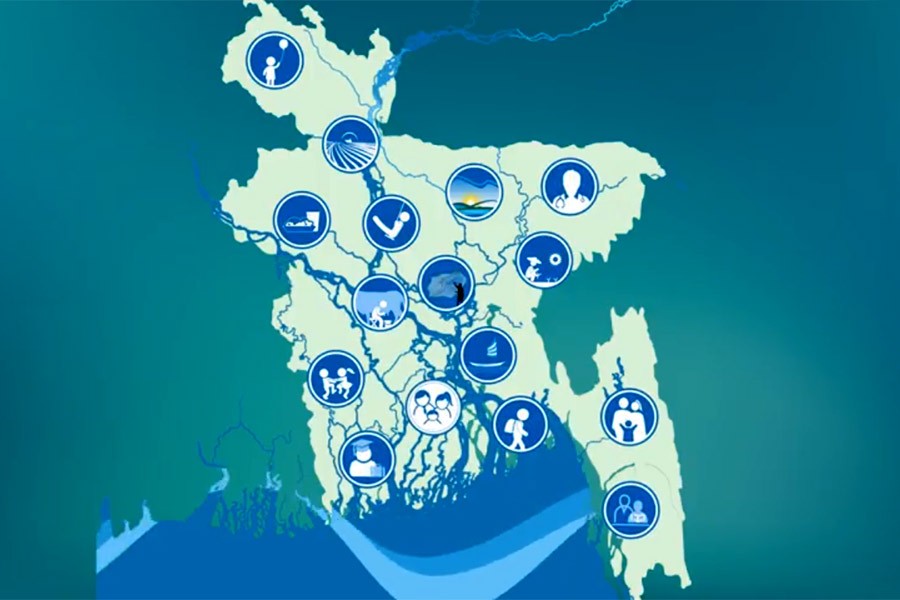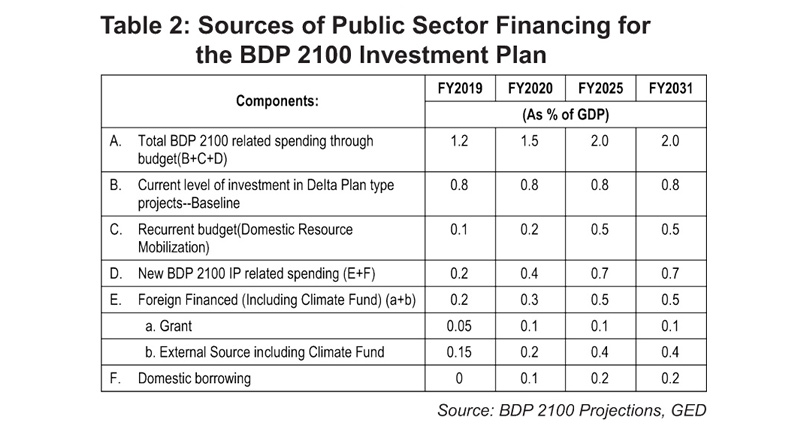Shamsul Alam | November 7, 2019

In view of the long term challenges presented by climate change and natural hazards, the government has formulated a long-term Bangladesh Delta Plan 2100 (BDP 2100) with the vision of ‘achieving safe, climate resilient and prosperous Bangladesh delta’. The BDP 2100 seeks to integrate the medium to long-term aspirations of Bangladesh to achieve upper middle income (UMIC) status and eliminate extreme poverty by 2030 and being a prosperous country around 2041 managing the longer term challenge of sustainable management of water, ecology, environment and land resources in the context of events like natural disasters and climate change. BDP 2100 is a long-term adaptive strategy offering nature-based solutions for handling adverse impacts of climate change.
Achieving higher level goals and implementation of BDP 2100 involve total spending on delta related interventions through new projects and continuation of old projects. Bangladesh Delta Plan 2100 was approved in the National Economic Council in September, 2018. The Financial Year 2019-20 is the first year of its implementation. BDP 2100 related projects cover the areas of: water management (water supply and sanitation, flood control, irrigation, dredging and navigation, building embankment, polder management, river restoration, excavation, land reclamation, drainage etc.), environment and climate change, disaster management, inland water transport, waste management which are implemented by 10 delta-related ministries/divisions. BDP 2100 proposed a total of 80 projects; 65 are physical projects and 15 are institutional and knowledge development projects at the first phase up to 2030. Its total capital investment cost is estimated at BDT 2,978 billion (US$ 37 billion) which is 12 per cent of the current GDP.
Presented below is a snapshot of how BDP 2100 is being implemented through development budget framework.
The total size of the Annual Development Programme (ADP) for the FY 2019-20 has been fixed at BDT 2,027.21 billion. Although public financing is a major source for BDP 2100 implementation, other sources of funding are also required such as private sector financing and through public-private partnership (GoB BDT 1,309.21 billion and Project Aid BDT 718.00 billion) and it consists of total 1564 projects. Out of the 1564 ADP projects, the General Economic Division (GED) of the Planning Commission identified 248 projects as related to BDP 2100 projects. Total ADP allocation for BDP 2100 related projects is BDT 219.19 billion (US$ 2.58 billion) which is 10.81 per cent of total ADP and 0.86 per cent of GDP. It was only 0.58 per cent of GDP during the formulation years — FY2015 to FY2018. In the current fiscal year, out of the total ADP allocation, GoB contribution is BDT 147.79 billion which is 7.29 per cent of ADP and 0.58 per cent of GDP, and Project Aid is BDT 71.41 billion which is 3.52 per cent of ADP and 0.28 per cent of GDP. BDP 2100 related ADP (2019-20) project allocation is shown in Table 1.

Water resources sector have 78 BDP 2100 related projects and ADP allocation for these projects is BDT 54.30 billion (US$ 0.64 billion) which is 2.68 per cent of total ADP and 0.21 per cent of GDP. Water resources projects’ main activities include flood control, river restoration, polder management, drainage & excavation etc., which are suggested measures BDP 2100. Most of the projects are implemented by Bangladesh Water Development Board (BWDB).
Agriculture sector (sub sector irrigation) contains 33 projects and ADP allocation is BDT 9.08 billion (US$ 0.11 billion) which is 0.45 per cent of total ADP and 0.04 per cent of GDP. These projects include irrigation activities in different hotspots and most of the projects are implemented by Bangladesh Agriculture Development Corporation (BADC). Similarly sub sector forestry has 16 BDP 2100 related projects and ADP allocation is BDT 5.48 billion (US$ 0.07 billion) which is 0.27 per cent of total ADP and 0.02 per cent of GDP. On the other hand fisheries sub-sector contains 14 projects and ADP allocation is BDT 5.33 billion (US$0.06 billion) which is 0.26 per cent of total ADP and 0.02 per cent of GDP. Food sub-sector has 6 projects and ADP allocation is BDT 7.07 billion (US$ 0.08 billion) which is 0.35 per cent of total ADP and 0.03 per cent of GDP.
Water transport sector (sub sector shipping) has 15 BDP 2100 related projects and ADP allocation is BDT 16.06 billion (US$ 0.19 billion) which is 0.79 per cent of total ADP and 0.06 per cent of GDP. Most of projects of this sub-sector are implemented by Bangladesh Inland Water Transport Authority (BIWTA). Rural development and rural institutions sector consists of 13 projects and ADP allocation is BDT 20.15 billion (US$ 0.24 billion) which is 1 per cent of total ADP and 0.08 per cent of GDP. Projects of this sector are mainly implemented by Local Government Engineering Department (LGED). Physical planning, water supply & housing sector has 68 BDP 2100 related projects and ADP allocation is BDT 10,0.10 billion (US$1.18 billion) which is 4.94 per cent of total ADP and 0.39 per cent of GDP. Power sector contains 5 BDP 2100 related projects and ADP allocation is BDT 162crore (US$ 0.02 billion) which is 0.08 per cent of total ADP and 0.01 per cent of GDP.
Physical planning, water supply and sanitation sector has the maximum allocation (46 per cent) for BDP 2100 related projects in the current ADP at BDT 100.10 billion (US$1.18 billion) whereas water resources sector has the second highest allocation (25 per cent) at BDT 54.30 billion (US$ 0.64 billion) compared to other sectors (figure 1). It is to be mentioned here that in ADP 2019-20, transport sector alone has got the highest allocation (26 per cent) whereas water resources sector allocation is only 2.79 per cent.

The financing plan for BDP 2100 is shown in Table 2. Given the current GDP projections — BDP 2100 estimates by 2020 — BDT 270 billion (US$ 3 billion) in public sector funds should be available, where BDT 450 billion ($6 billion) will be required in 2025. But according to this analysis, currently public investment for BDP 2100 related projects is only BDT 184 billion (US$ 2 billion) which indicates that the expected total expenditure on the investment plan remains below the resources the Delta Plan aims to make available. Public investment is required for BDP investment is only BDT86 billion ($1 billion) for 2020. So, there is the obvious need to invest required public resources for proper implementation of BDP 2100 through inclusion of new projects/programmes in the ADP. This additional investment is necessary to ensure long term water and food security, economic growth and environmental sustainability through building climate resilience of the country. BDP 2100 related projects in the first phase should be picked up by the ministries, particularly by the 10 Delta ministries as identified in BDP 2100.

Implementation of the BDP 2100 proposes total spending on delta-related interventions through adopting new projects and maintenance of old projects, amounting to about 2.5 per cent of GDP per annum. This compares with an annual spending of a mere 0.86 per cent of GDP presently which needs to be enhanced by taking up new projects. Out of the total required 2.5 per cent of GDP, some 0.5 per cent of GDP could be funded by the private sector and about 2 per cent of GDP would need to be executed through the public sector. About 0.5 per cent of GDP would need to be spent on O&M activities. As noted, presently the government spends about 0.86 per cent of GDP on BDP 2100 related projects, whereas the needs are estimated at around 2 per cent of GDP. Finding an additional 1.2 per cent of GDP for public financing of the BDP 2100 is required for this purpose. BDP 2100 may guide them in setting project implementation priority.
In view of the above, it may be noted that successful implementation of Bangladesh Delta Plan 2100 depends largely on meeting the financial challenges. Although public financing is a major source for BDP 2100 implementation, other sources of funding are also required such as private sector financing and through public-private partnership in projects like embankment-cum-roads, tapping Green Climate Fund, funding from development partners. The strategy for public funding is a combination of tax financing, application of cost recovery based on beneficiary pays principle and mobilising foreign funding. Apart from this, aligning delta implementation works with Annual Development Programme, designing the appropriate mode of financing for PPP related projects, practising appropriate feasibility studies before taking up delta investment works (e.g. dredging, tidal river management, restoring navigational channels and afforestation etc.) and effective O&M deserve priority attention for the successful implementation of BDP 2100.
In devising the Annual development Programme, the 10 Delta related ministries may come in a cluster to claim for more MTBF fund allocation against BDP 21000 target attaining projects. Nationally the time has come to create Delta specific funds in budgetary allocations giving more focus on building climate proof Delta projects.
Dr. Shamsul Alam is Member (Senior Secretary), General Economics Division, Bangladesh Planning Commission and lead coordinating author of Bangladesh Delta Plan 2100.
sabau47@yahoo.com
The article appeared in the Financial Express on 1 November 2019
